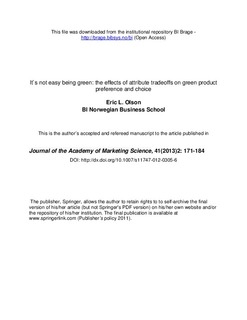It`s not easy being green: the effects of attribute tradeoffs on green product preference and choice
Journal article, Peer reviewed

View/
Date
2013Metadata
Show full item recordCollections
- Scientific articles [2173]
Original version
10.1007/s11747-012-0305-6Abstract
Despite widespread pro-green attitudes, consumers frequently purchase non-green alternatives. One possible explanation for this value–action gap is the tradeoffs that green products often force on their users: higher prices, lower quality, and/or reduced performance. The current study uses conjoint analysis to uncover the attribute preferences of car and TV buyers when green attributes are negatively correlated with conventional attributes. These attribute preferences are then used to predict choice among sets of green and less green alternatives currently sold in the marketplace. Strong preferences for green products are found when tradeoffs are not apparent, but preference shifts significantly to less green compromise alternatives when the actual attribute tradeoffs are considered. Although general preference is reduced by tradeoffs, a green product offering some compensatory advantage on a conventional attribute does attract a broader spectrum of consumers, while only “dark green” consumers are willing to pay the price to go green when the product offers few compensatory qualities. In all cases, however, predicted buyers of the greenest technologies offset some of their environmental benefits by choosing more energy-thirsty specifications on negatively correlated conventional attributes. Managerial and public policy implications of the findings are then discussed
Description
The final publication is available at www.springerlink.com